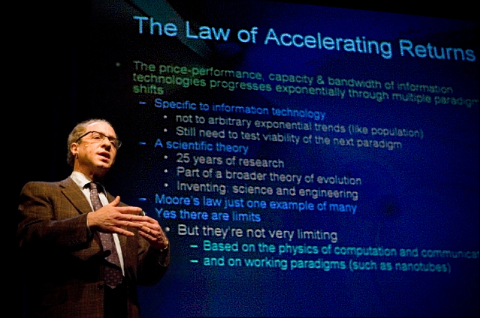For education, like many other facets of society, Kurzweil believes that we will see a decentralization as the technology improves. The persistence of a centralized model for a variety of industries, education included, was built upon a past that saw knowledge concentrated, resources inefficiently applied to challenges, and politics impeding progress.
As with all of our other institutions we will ultimately move toward a decentralized educational system in which every person will have ready access to the highest-quality knowledge and instruction. We are now in the early stages of this transformation, but already the advent of the availability of vast knowledge on the Web, useful search engines, high-quality open Web courseware, and increasingly effective computer-assisted instruction are providing widespread and inexpensive access to education.The future of education is likely to become not only destabilized, in a way that promotes the most innovative educators, but could see the institutions themselves shift toward a location-independent model where the students spend the majority of their learning time wherever they choose to call the classroom.
Most major universities now provide extensive courses online, many of which are free. MIT's OpenCourseWare (OCW) initiative has been a leader in this effort. MIT offers nine hundred of its courses—half of all its course offerings—for free on the Web.56 These have already had a major impact on education around the world. For example, Brigitte Bouissou writes, "As a math teacher in France, I want to thank MIT ... for [these] very lucid lectures, which are a great help for preparing my own classes." Sajid Latif, an educator in Pakistan, has integrated the MIT OCW courses into his own curriculum. His Pakistani students regularly attend virtually-MIT classes as a substantial part of their education.57 MIT intends to have everyone of its courses online and open source (that is, free of charge for noncommercial use) by 2007.Since Kurzweil wrote The Singularity in 2005, not only have we seen online education come into its own, but institutions such as MIT realize the social value in bringing high-quality learning resources to the public for little to no cost. And they're not alone. There has been much hype surrounding the MOOC phenomena, but the long-term course seems to be more stable for these online education systems. Entrepreneurs are investing billions of dollars into underdeveloped regions.
The U.S. Army already conducts all of its nonphysical training using Web-based instruction. The accessible, inexpensive, and increasingly high-quality courseware available on the Web is also fueling a trend toward homeschooling.
The cost of the infrastructure for high-quality audiovisual Internet-based communication is continuing to fall rapidly, at a rate of about 50 percent per year, as we discussed in chapter 2. By the end of the decade it will be feasible for underdeveloped regions of the world to provide very inexpensive access to high-quality instruction for all grade levels from preschool to doctoral studies. Access to education will no longer be restricted by the lack of availability of trained teachers in each town and village.Access will be guaranteed through low-cost technology and the entrepreneurship of innovators that understand that the way we have been providing services like education is based on outmoded models that have little place in the modern world.
As computer-assisted instruction (CAl) becomes more intelligent the ability to individualize the learning experience for each student will greatly improve. New generations of educational software are capable of modeling the strengths and weaknesses of each student and developing strategies to focus on the problem area of each learner. A company that I founded, Kurzweil Educational Systems, provides software that is used in tens of thousands of schools by students with reading disabilities to access ordinary printed materials and improve their reading skills.The world is changing faster than ever before, and the future will make your head spin.

No comments:
Post a Comment